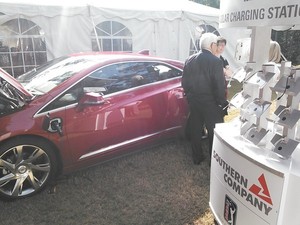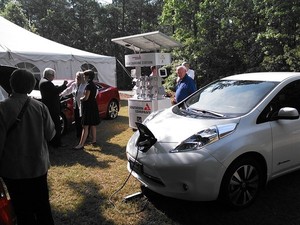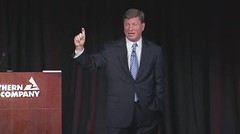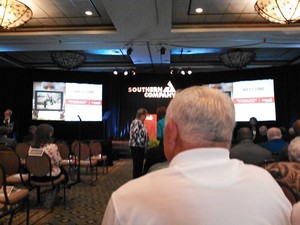 Solar car charging station at the
Southern Company Stockholder Meeting:
that’s new.
Other solar changes were detectable, if you knew what to look for,
and with hints from
SO CEO Tom Fanning and
new R&D VP Larry Monroe
here are some, while we’re waiting on SO for video and transcript.
Solar car charging station at the
Southern Company Stockholder Meeting:
that’s new.
Other solar changes were detectable, if you knew what to look for,
and with hints from
SO CEO Tom Fanning and
new R&D VP Larry Monroe
here are some, while we’re waiting on SO for video and transcript.
Two demonstration solar charging cars were on the lawn outside the breakfast tent:
 a Cadillac and I think the other one was a Nissan.
a Cadillac and I think the other one was a Nissan.
There was a tiger team report last summer: it was internal, and much of it is being implemented. When Tom Fanning included his announcement of that tiger team last year in an answer to one of my questions, he never said the report would be public. It’s pretty clear from talking to Fanning and Monroe afterwards that that report is very unlikely to be made public. The phrase Monroe used was “brutally honest”. Who knows? Maybe it even mentioned that phrase popular on Wall Street now: the “death spiral” for utilities that don’t do solar alluded to by Steven Chu; renewables also figured into the UBS downgrade of SO to sell of May 2014. I, for one, can understand why SO might not want to publish a report like that, yet would want to proceed with doing something about it.
 OK, what are they doing?
Some things are subtle.
Two years ago
Tom Fanning was quoted by Joseph Rago in the WSJ as saying:
OK, what are they doing?
Some things are subtle.
Two years ago
Tom Fanning was quoted by Joseph Rago in the WSJ as saying:
“Now I’m as excited about renewables as anybody. But they’re a niche play.”
Nobody called solar or wind power a niche play this time. And at least once this time, Fanning named “renewables” before “clean coal” in a list of “all of the above” energy sources. For years Fanning has repeatedly listed this order:
nuclear, “21st century coal”, natural gas, renewables, and efficiency.
Putting renewables higher up the list is a change in emphasis.
Fanning even emphasized Georgia Power’s claim, listed in Southern Company’s Renewables and Distributed Generation PDF:
Georgia Power is implementing the largest voluntary solar energy portfolio of any utility in the nation. Recent phases of development, called the Advanced Solar Initiative (ASI), include plans to secure PPAs with large-scale solar projects through a competitive-bidding process, as well as allowances for small- and medium-scale distributed generation. Through various phases, installed capacity is projected to total nearly 800 MW of solar by 2016. Georgia Power has been recognized by the Solar Electric Power Association as one of the top 10 utilities in the U.S. for solar.
Sure, Tom Fanning and Paul Bowers claimed Plant Vogtle was a success and Fanning once again did his (if he hasn’t patented it he should) paper cup demonstration of the emergency nuke water-dousing system.
And this time Fanning, while admitting cost overruns and problems at the “clean coal” experiment at Plant Ratcliffe in Kemper County, Mississippi, he doubled down on the “advantages” of capturing carbon only to sell it to oil companies to pump more oil out of the ground, which would then be burned, producing more CO2. He also emphasized plans (previously announced 1 August 2008 by previous SO CEO David Ratcliffe) to sell the Kemper County technology to China. Good luck with that, since he also didn’t deny that no power whatever had been generated from coal at Plant Ratcliffe yet.
 SO cannot bring itself to abandon its big baseload projects at Plant
Vogtle or Plant Ratcliffe, but it is doing some additional
interesting things.
SO cannot bring itself to abandon its big baseload projects at Plant
Vogtle or Plant Ratcliffe, but it is doing some additional
interesting things.
Fanning said he didn’t believe wind off the Georgia coast was cost-effective. After the meeting Monroe told me lower-speed wind turbines would be necessary. Be that as it may, both of them also emphasized SO’s purchases of wind energy from other states, such as mentioned in that Renewables and Distributed Generation PDF:
Southern Company has ongoing wind research projects, and some of our subsidiaries are importing wind energy from other regions when it is cost-effective based on the delivered price to the Southern Company system’s service territory.
CEO Fanning said in the meeting he still didn’t think it was time for the utility-owned rooftop solar idea he mentioned last year (and that former Department of Energy Secretary Steven Chu is also advocating).
 After the meeting, Fanning told me one result of the internal tiger team report
was that SO was buying even more solar power than it was required to,
including bidding for solar plants on military bases.
Kristi Swartz
who wrote a week before about that Georgia 3×30 Project,
was at yesterday’s SO stockholder meeting.
After the meeting, Fanning told me one result of the internal tiger team report
was that SO was buying even more solar power than it was required to,
including bidding for solar plants on military bases.
Kristi Swartz
who wrote a week before about that Georgia 3×30 Project,
was at yesterday’s SO stockholder meeting.
During that meeting, Fanning said he thought the missing element for distributed solar was storage. Ok, fine; that’s a popular delaying tactic. But then it got interesting: he alluded to two storage projects SO is working on.
 Fanning SO is involved in a major west-coast storage project.
He also said he drives and electric car.
Before the meeting he told me it was a Tesla,
which is not a secret, given others have seen it in the SO parking lot in Atlanta.
Are we supposed to put T for Tesla and S for storage together
and infer that SO is involved in
Tesla’s battery gigafactory?
Fanning SO is involved in a major west-coast storage project.
He also said he drives and electric car.
Before the meeting he told me it was a Tesla,
which is not a secret, given others have seen it in the SO parking lot in Atlanta.
Are we supposed to put T for Tesla and S for storage together
and infer that SO is involved in
Tesla’s battery gigafactory?
Fanning also talked about SO involvement in research on
Compressed Air Energy Storage (CAES).
SO gets the credit for initiating that research,
“Southern Company approached Sandia National Laboratories (SNL) with a request to evaluate the business case for additional storage on their bulk power grid,”
in
Southern Company Energy Storage Study: A Study for the DOE Energy Storage Systems Program,
by James Ellison, Dhruv Bhatnagar, Clifton Black, and Kip Jenkins,
Sandia National Laboratories Report, SAND2013-2251, March 2013.
 That report also compares flywheel and battery storage systems.
Fanning in the meeting mentioned possible storage in caves
or otherwise underground in a variation on the kind of pumping
used in the Kemper Coal carbon-capture to oil extraction cycle.
While I’m nervous about anything, even air, being pumped into
the ground, especially if it’s underneath our drinking water aquifer,
at least SO is trying something.
That report also compares flywheel and battery storage systems.
Fanning in the meeting mentioned possible storage in caves
or otherwise underground in a variation on the kind of pumping
used in the Kemper Coal carbon-capture to oil extraction cycle.
While I’m nervous about anything, even air, being pumped into
the ground, especially if it’s underneath our drinking water aquifer,
at least SO is trying something.
While it’s not clear to me why mighty Southern Company can’t make a big bet business case out of distributed solar and wind without improved storage, I wholeheartedly agree that improved storage would be a great thing. As Kristi Swartz wrote in that article about the Georgia Power and Army solar Georgia 3×30 Project, Georgia “could be a model for other states”. If Southern Company can solve the storage problem too, SO can lead the country and the world.
-jsq
Short Link:
